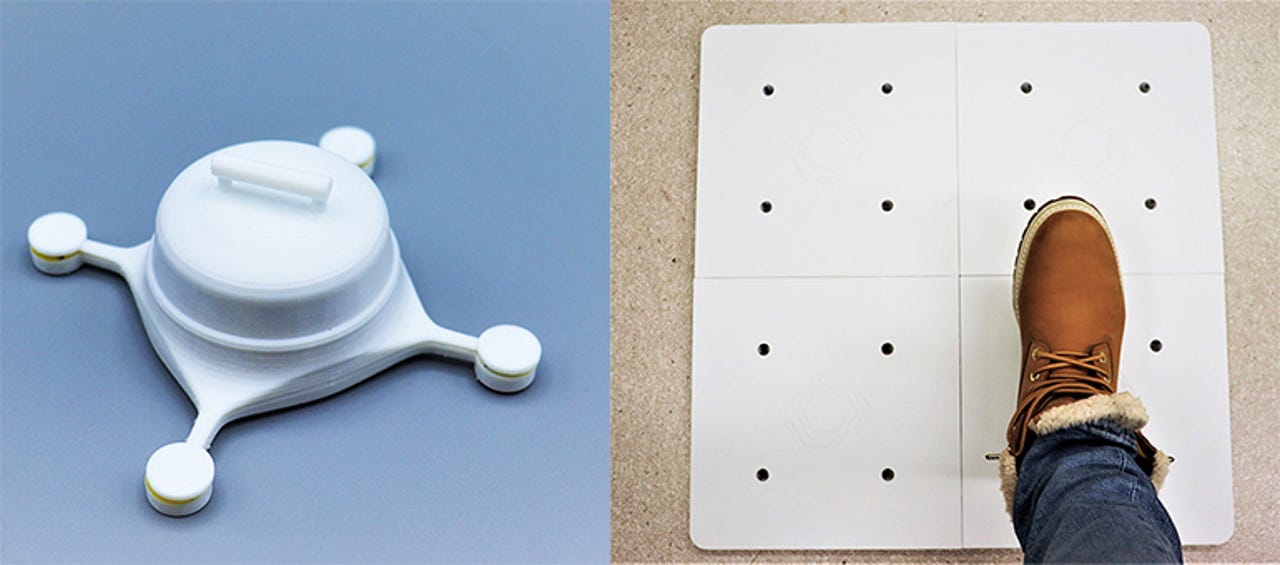
































Somalytics products on show at CES 2022: SomaControl (left) and SomaSense (right).
Images: SomalyticsSomalytics, a startup launched in November 2021 to commercialise technology developed by researchers at the University of Washington (in collaboration with CoMotion), is showing off two innovative sensor-driven devices at CES 2022.
SomaControl is a 3D gesture monitor that allows users to interact with and control digital devices via no-contact hand movements, while SomaSense is a flexible 3D sensing floor mat that detects and analyses human presence, gait and foot pressure.
Barbara Barclay, CEO of Somalytics
Image: Somalytics"These new products are a great example of the kind of innovation that is possible with our new kind of capacitive sensors," said Barbara Barclay, CEO of Somalytics, in a statement. "We look forward to igniting discovery across many industries to pioneer better, faster and less-expensive applications for human computer interaction. Our devices will enable life-changing applications in assistive technology, health and wellness, industrial safety, and transportation in addition to better experiences in consumer electronics, gaming and wearables as well as many other areas."
SEE: CES 2022: This Labrador "Retriever" robot assists those with chronic pain
Both demonstration products are based on Somalytics' patent-pending Carbon-nanotube Paper Composite (CPC) capacitive sensors, which the company says deliver greater sensitivity, smaller size and lower cost than conventional capacitive proximity sensors.
The CPC sensors consist of tiny carbon nanotubes embedded within the structure of paper, which undergoes water-induced fracture to reorganise the conductive nanotube fibres parallel to one another. According to Somalytics, the flexible paper-based sensors, which are 1-5mm in diameter and just 0.1mm thick, offer "unprecedented sensitivity to human tissue", detecting human presence at up to 20 centimetres. The sensors are also "faster and better than infrared", the company says, potentially ushering in "a new generation of touchless technology applicable to almost any interaction between humans and machines".
SomaControl allows users to interact with and control a digital device using hand movements with no contact.
Image: SomalyticsOne interesting potential application is eye tracking in AR/VR glasses without the need for cameras. Exceptional electrical sensitivity means the CPC sensors can detect the movement of the cornea relative to the spherical curvature of the eye, with processing speed under 3ms and sampling rates up to 1000Hz. "We have a prototype -we're not actually launching it here, because it's not quite ready for CES; it has three sensors on each eye," Barclay -an expert in this particular field -told ZDNet.
Turning to the products on show at CES, Barclay described the use case for SomaControl. "It's just this little device -- anybody can put their finger near it, not touching anything -- and we have it controlling three different lights. We are also demonstrating the same device to look at a bunch of photos on a computer -- you gesture left and right to scroll through and move your hand up and down to zoom.
"The SomaSense mat is two feet by two feet and has a total of 16 sensors in it," Barclay continued. "It's attached to a smart device -- maybe your doctor is monitoring you because you have Parkinson's or you're elderly or frail. Its fundamental use is to analyse your gait as you walk over it, detecting differences in heel and foot pressure, and the pace."
SomaSense observes, monitors and reports on human wellness factors, including presence, gait and foot pressure.
Image: SomalyticsThere are clearly many potential applications of Somalytics' sensor technology, including presence detection for security purposes. "The bigger problem is 'what do we do first?'," Barclay told ZDNet. "There are around 10 different multi-billion-dollar markets, and we're talking to bigger companies who are interested in having us do a proof-of-concept for certain paths, so we don't just build stuff.
"I definitely don't see us just providing core technology," Barclay continued. "We'll also do co-development projects for commercial products; hopefully we'll do two or three this year. We're a startup and we have limited funding right now -- we'll get another round in June or July -- and it'll be a deciding point at the end of this month what those projects are. We expect to do something like an 'Intel Inside' concept in the early days; we don't have a brand name, nobody knows who we are, why would you buy it? Most likely it'll be a combination of B2B and B2C."
With years of research behind its core technology and four patent (pending) families licensed from the University of Washington, Somalytics has little to fear from competitors for the foreseeable future. With mass production expected to start this year, it'll be interesting to see what the company does next.
 Tags chauds:
Innovation et Innovation
Tags chauds:
Innovation et Innovation